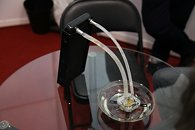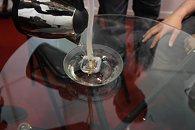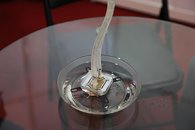Wednesday, June 1st 2016

Raijintek Unveils its First Passive Liquid Cooler
Raijintek unveiled its first liquid cooler that works without a prime-mover for the coolant (i.e. no pump). Further, its radiator lacks fans (i.e. no power, no noise). This closed-loop cooler works in the same principle as a heat pipe, with a combination of convention and phase-change doing the heavy lifting of heat-transfer. Heat from the source (your CPU) causes the special coolant to change phase to vapor, move to the heat-exchanger (radiator), where it condenses back to liquid, and flows back down to the block. We saw this contraption in action, and we can tell you that it works. It is ready for the real-world. Raijintek spent vast amounts of R&D budget developing this technology, and has patented it in most markets. We could see the first products based on this technology very soon.



25 Comments on Raijintek Unveils its First Passive Liquid Cooler
www.tomshardware.com/news/silverstone-td04-pumpless-liquid-cooling,27023.html
that was two years ago, from Silverstone, so forgive me for being sceptical about ever seeing this in stores, also "first"? yeah, right...
Anyways why not show a real test of this in action ?, that supposed to be hot steamy water ?, umm i need to see it actually working not this rubbish.
I first saw this when searching for supercomputers and liquid cooling so they have the expertise
Also the design optimally requires the block to be horizontal or the positioning of the inlet and outlet to be upper most.
I cant be the first one to realize
And until the cooling efficiency is tested and verified, it is to early to draw a conclusion.
But if this does provide the cooling of a custom loop without a pump, sign me up.
spend millions of dollars on something else
...
profit?
Yeah, it had a pump, but still it was passive-cooled..
This sounds interesting, but we'll have to see some reviews first and then compare the price with the performance and the competition. If this will be in the 3 digits $$$ area from price perspective and offer more or less the same performance as a 30$, typical air cooler ... it will not be such amazing product anymore. But let's see there could still be a market for it, for the guys which would pay anything to have a silent, high performance computer.
Refrigerants used in window AC units or central air work well when under pressure. However without pressure and open to the atmostphere most refrigerants evaporate very, very rapidly. In a closed loop like this it can be contained and even have a bit of pressure to it, if the loop is strong enough.
The more refrigerant heats up the more it expands, if this loops heats up to much, the weakest link in the loop will break.
So its prolly safe to say the bulk of the R&D went into just developing the refrigerant.
Note:Some people might call refrigerant Freon, but Freon was a brand name and mostly associated with old R-12 originally.